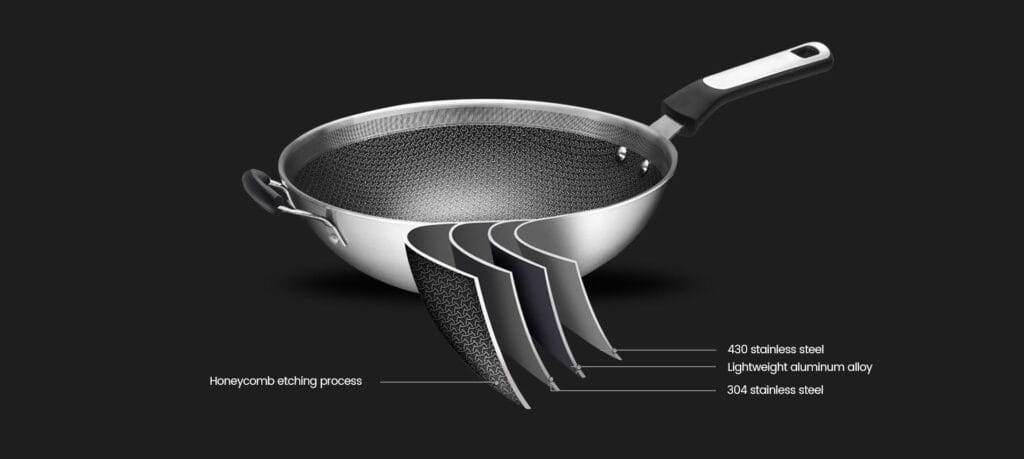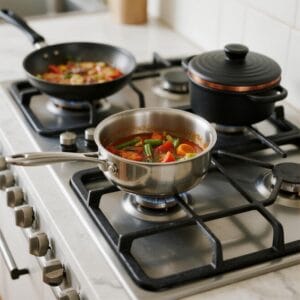Introduction
Triply circle material is becoming increasingly popular in cookware manufacturing due to its unique composition and outstanding heat conductivity. It consists of three bonded layers—typically stainless steel, aluminum, and stainless steel—which work together to offer the perfect balance of heat distribution, durability, and safety. Triply cookware is highly favored by chefs and cooking enthusiasts for its ability to cook food evenly and efficiently.
In this article, we explore how triply circle material is used in cookware manufacturing, its benefits, key applications, and why it is considered an optimal choice for high-quality cookware.
What Is Triply Circle Material?
Triply circle material is a composite material made by bonding three distinct layers of metals, each contributing unique properties to create an efficient and durable cooking surface. Let’s break down the structure, composition, manufacturing process, and specifications of triply circle material:
- Product Structure and Composition: The triply circle material consists of three layers—an inner layer, a middle core, and an outer layer:
- Inner Layer (Cooking Surface): The inner layer is typically made of food-grade stainless steel, which is non-reactive and ensures that no harmful substances are released into the food. This layer is in direct contact with the food and provides a safe, easy-to-clean surface.
- Middle Layer (Core): The middle layer is aluminum, which acts as the core for heat conductivity. Aluminum is an excellent heat conductor, allowing for even heat distribution throughout the cookware and preventing hot spots that could burn food.
- Outer Layer: The outer layer is usually made of magnetic stainless steel, which provides durability and makes the cookware compatible with induction cooktops. This layer also adds structural strength and resistance to wear and tear.
- Manufacturing Process: The production of triply circle material involves a process called cladding, where the three metal layers are bonded together under high heat and pressure to form a single unified sheet. This method ensures that the metals are permanently fused, allowing for even heat transfer and enhanced durability. The resulting composite sheets are then shaped, stamped, and welded to produce various types of cookware, such as pans, pots, and skillets.
- Specifications: Triply circle material is available in various thicknesses to suit different types of cookware. The thickness of the aluminum core can vary depending on the desired heat conductivity and cooking performance. Typical specifications for triply circle material include:
- Thickness Range: Common thicknesses range from 2.5 mm to 5 mm, with thicker materials providing better heat retention and distribution.
- Diameter Options: The material can be cut into different diameters to accommodate various sizes of cookware, from small saucepans to large stockpots.
- Surface Finish: The stainless steel layers can be polished to a mirror or brushed finish, providing either a shiny or matte look based on consumer preferences.
The combination of these three layers results in a material that offers the best properties of each metal—aluminum for heat conductivity and stainless steel for durability and non-reactivity—making triply circle material a superior choice for high-quality cookware.

Advantages of Using Triply Circle Material in Cookware
Triply circle material offers numerous advantages that make it ideal for cookware manufacturing:
- Even Heat Distribution: The aluminum core ensures that heat is distributed evenly across the cookware surface, eliminating hot spots that could lead to uneven cooking or burning.
- Durability: Stainless steel layers offer excellent durability and corrosion resistance, making triply cookware suitable for long-term use and able to withstand rigorous kitchen conditions.
- Non-Reactive Surface: The stainless steel used in triply cookware is non-reactive, making it safe to cook acidic foods without worrying about altering the taste or quality of the food.
- Energy Efficiency: The even heat distribution of triply cookware helps reduce cooking times, making it more energy efficient compared to other types of cookware.
Key Applications of Triply Circle Material in Cookware Manufacturing
Triply circle material is used in a variety of cookware types to enhance cooking performance and reliability:
- Frying Pans and Skillets: Triply circle material is widely used in the production of frying pans and skillets. The aluminum core provides even heat, ensuring perfect searing and browning of food, while the stainless steel exterior is easy to clean and highly durable.
- Saucepans and Stockpots: Saucepans and stockpots made with triply material are excellent for making sauces, soups, and stews, as they maintain a consistent temperature and prevent hot spots.
- Sauté Pans: Sauté pans benefit from triply construction as the material ensures precise temperature control, which is crucial for sautéing vegetables or proteins.
- Dutch Ovens: Triply material is also used in Dutch ovens, providing the necessary heat retention and even cooking that makes these pots perfect for slow-cooking recipes.
Features of Triply Circle Material
Triply circle material possesses several features that make it a preferred choice for cookware manufacturing:
- Multi-Layer Construction: Triply material combines multiple metals to create a single, high-performing product. The stainless steel layers provide strength, while the aluminum core ensures even heating.
- Induction Compatibility: The stainless steel exterior makes triply cookware suitable for use on induction cooktops, providing versatility across various heat sources.
- Heat Conductivity: Aluminum is a highly conductive metal, which means that triply cookware heats up quickly and retains heat well, making it an excellent choice for cooking a wide variety of dishes.




Comparisons: Triply Circle Material vs. Other Cookware Materials
When compared to other cookware materials, triply circle material offers several distinct advantages:
- Triply vs. Stainless Steel: Standard stainless steel cookware lacks the even heat distribution that the aluminum core in triply provides. Triply cookware is superior in terms of heat conductivity and energy efficiency.
- Triply vs. Non-Stick Cookware: Non-stick cookware offers convenience but lacks the durability and high-heat capability of triply cookware. Triply material is more versatile and can handle higher cooking temperatures.
- Triply vs. Copper Cookware: Copper cookware is highly conductive but requires more maintenance to prevent tarnishing. Triply cookware offers similar heat distribution with less upkeep and at a more affordable price.
Benefits of Triply Circle Material in Cookware
- Consistent Cooking Results: The even heat distribution ensures that food is cooked consistently, whether searing, boiling, or simmering.
- Versatility: Triply cookware is versatile enough for a variety of cooking methods, including sautéing, frying, boiling, and slow-cooking.
- Ease of Maintenance: The stainless steel exterior is easy to clean and resistant to scratches, making triply cookware a low-maintenance option.
- Healthier Cooking: The non-reactive stainless steel ensures that no harmful chemicals or metals leach into the food, making triply cookware a healthy choice.
Challenges in Using Triply Circle Material in Cookware
Despite its numerous advantages, there are some challenges associated with using triply circle material in cookware:
- Weight: Triply cookware can be heavier than other types of cookware due to its multi-layer construction. This can make it cumbersome for some users.
- Cost: The manufacturing process for triply material is more complex, which can make it more expensive compared to other cookware options like aluminum or basic stainless steel.
Future Trends for Triply Circle Material in Cookware
The demand for high-quality, durable, and energy-efficient cookware is expected to grow, and triply circle material is likely to play a significant role in meeting this demand. Innovations in bonding technology and the use of alternative core materials may lead to even better heat distribution and lighter products in the future. Additionally, the increased popularity of induction cooking is driving demand for cookware that is compatible with a wide range of heat sources, a feature well-supported by triply circle material.
FAQs about Triply Circle Material in Cookware Manufacturing
- What makes triply circle material different from regular stainless steel cookware?
- Triply material includes an aluminum core that provides superior heat distribution compared to regular stainless steel.
- Is triply cookware suitable for induction cooking?
- Yes, the stainless steel exterior of triply cookware makes it compatible with induction cooktops.
- How does triply cookware improve cooking efficiency?
- The aluminum core ensures even heat distribution, which helps reduce cooking times and save energy.
- Is triply cookware non-stick?
- No, triply cookware is not inherently non-stick, but it offers excellent searing capabilities and is easy to clean.
- Why is triply cookware heavier than other types?
- The multi-layer construction, which includes stainless steel and aluminum, contributes to the added weight.
- Can I use triply cookware in the oven?
- Yes, most triply cookware is oven-safe and can handle high temperatures, making it versatile for different cooking methods.
- How should I clean triply cookware?
- Triply cookware can be cleaned with warm soapy water and a soft sponge. Avoid using harsh abrasives to maintain its shine.
- Does triply cookware require seasoning?
- No, unlike cast iron, triply cookware does not require seasoning.
- Is triply cookware dishwasher-safe?
- While many triply cookware items are labeled as dishwasher-safe, handwashing is recommended to maintain their finish and longevity.
- What types of dishes can be cooked using triply cookware?
- Triply cookware is versatile and can be used for sautéing, frying, boiling, braising, and slow cooking.
- Does triply cookware warp under high heat?
- No, triply cookware is designed to withstand high heat without warping, thanks to its sturdy construction.
- How does triply cookware compare to copper cookware?
- Triply cookware offers similar heat conductivity with less maintenance and at a more affordable price compared to copper cookware.
- Is triply cookware safe for acidic foods?
- Yes, the stainless steel surface is non-reactive, making it safe for cooking acidic foods like tomatoes and citrus.
- What are the common sizes available for triply cookware?
- Triply cookware is available in a wide range of sizes, from small saucepans to large stockpots, to suit various cooking needs.
- Why is triply cookware more expensive than aluminum?
- The manufacturing process for bonding multiple layers is more complex, leading to a higher cost compared to single-material cookware like aluminum.
Conclusion
Triply circle material is a game-changer in the cookware manufacturing industry. Its multi-layer construction offers the best of both stainless steel and aluminum, providing even heat distribution, durability, and versatility. Although it comes with a higher cost and heavier weight, the benefits of consistent cooking results, health safety, and energy efficiency make it a preferred choice for both professional chefs and home cooks. As the demand for high-quality cookware continues to grow, triply circle material is set to play an even more significant role in kitchens around the world.






